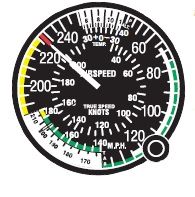In your September 2022 issue, in response to Scott Burkhart’s email, you unnecessarily scare him by stating that VNE is a true airspeed (for his Mooney). In fact, for him, and the vast majority of people who fly certified planes, VNE is an indicated airspeed that is safe to fly (flutter-wise) up to the aircraft’s ceiling.
You had to walk back the “VNE is a true airspeed” claim once before, in May 2011. Why shoot yourselves in the foot and have to do it again?
Other than this, great work. I have been enjoying and learning from your magazine for many years now.
Karol Zadora – Via email
Yeah, we have a lot of egg on our face. When Mr. Burkhart’s letter came in, we remembered an article on the subject from a few years back and eagerly did some cut and paste from the first article, but not the follow-up. There even were faint voices in the back of our mind about it, one saying, “This doesn’t sound right,” and the other whispering, “Haven’t we been down this path before?” But we didn’t listen to them.
We owe Mr. Burkhart and other readers an apology. Thank you, Karol, for the gentle nudge on the rudder and your kind words.
Here’s what we should have said in response to Mr. Burkhart, from the follow-on article, “VNE Revisited,” which appeared in our May 2011 issue: “The never-exceed speed is calculated by reference to the aircraft’s design dive speed, or VD, and is limited to 0.9 of VD. The design dive speed is one established by the manufacturer and is the highest speed at which the airframe normally will be tested. A successful VD test will be one in which flutter does not occur.”
Quoting from a then-recent Flying magazine article by Peter Garrison, we noted, “VNE, the redline on the airspeed indicator, is an indicated airspeed, but the critical flutter speed may be a true airspeed. So the margin separating VNE from the critical flutter speed gets smaller as you gain altitude.”
We tried to wrap a bow around it in May 2011 by saying, “[W]hile in rarified circumstances VNE can be a true airspeed, for the airplanes most of us fly, it simply isn’t. It’s clearly an indicated speed, unless the aircraft’s limitations and markings state otherwise, as is the case with many gliders and other aircraft too numerous to list here. We regret the error. The point we were trying to make—that flutter’s onset is a function of true airspeed rather than indicated—remains both valid and an important distinction.” Tom Turner’s article, The Yellow Arc, beginning on the next page, has more detail on how these speeds are defined and calculated.
UNLEADED AVGAS
Thanks for your coverage of GAMI successfully obtaining its STC for its unleaded G100UL aviation gasoline, and especially for some of the operational details GAMI has shared about the fuel. I hadn’t seen many of the details anywhere else. Advising that it will have a different color and what it will look like when mixed with 100LL alone answered some questions I had with others hanging around the FBO had.
You wrote that the slight (four percent) increase in G100UL’s weight will have a negligible effect on an aircraft’s empty weight. How does that work?
Mike Stevens – Via email
Four percent is…four percent. If we were talking about four percent of the aircraft’s maximum gross takeoff weight, we could certainly see a problem. But we’re talking about the unusable fuel that’s considered part of its empty weight.
Let’s take my Beech C33A Debonair as an example. It has two 40-gallon main tanks, for 80 gallons total, of which 37 gallons a side are usable, for a maximum usable fuel quantity of 74 gallons. That leaves six gallons of unusable fuel aboard at all times. Six times 100LL’s weight of six pounds is 36 pounds. Six times 6.25 (G100UL’s weight) equals 37.5 pounds, a 1.5-pound difference. That’s pretty negligible. My tip-tanked Debonair weighs about 2200 pounds empty, with a maximum gross weight of 3550 pounds. Add a pound and a half to either of those numbers and it’s hard to find the problem, especially since there’s probably that much weight in pens, pencils and other detritus riding around under the carpet.




